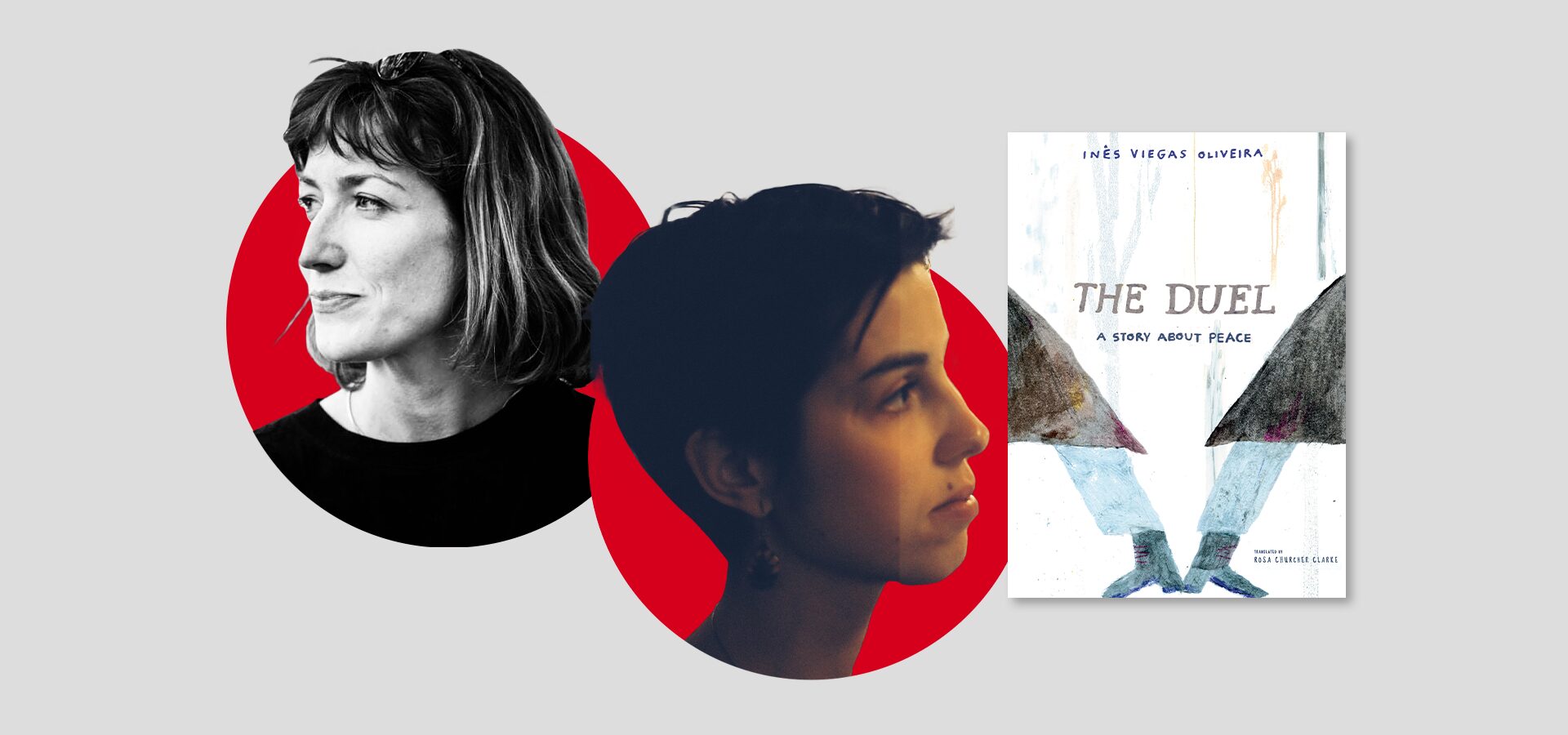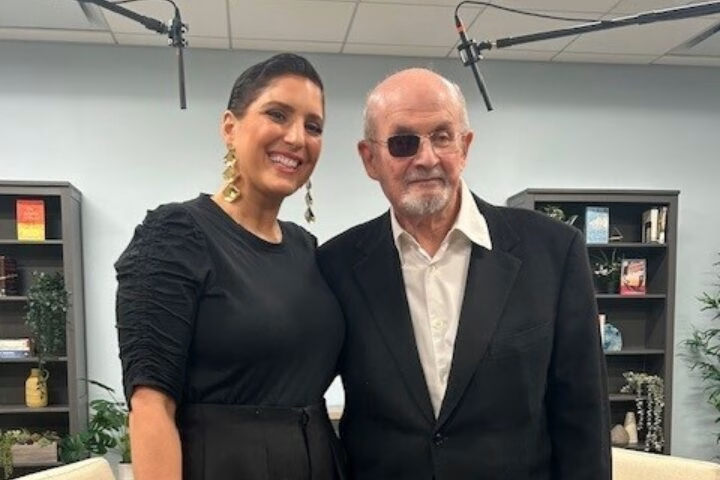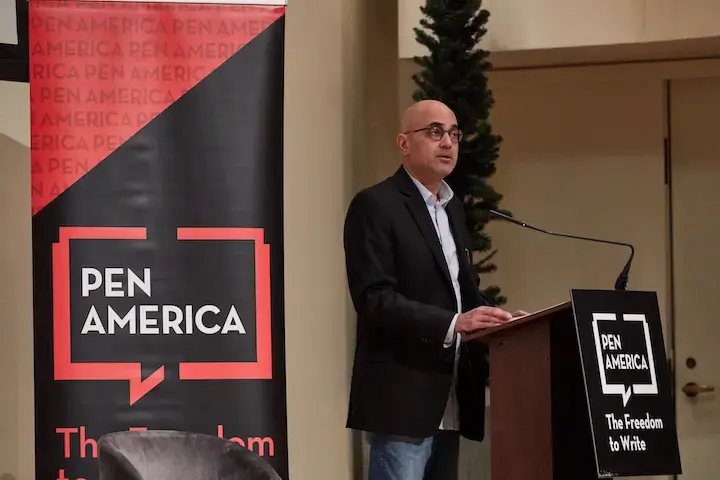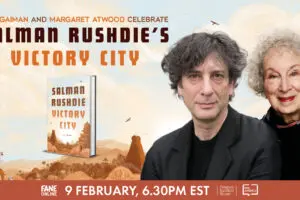
Inês Viegas Oliveira’s The Duel: A Story About Peace (Seven Stories Press, 2024 – translated by Rosa Churcher Clarke), is a poignant tale about a duel that never takes place. The main character marches through watercolor illustrations that gradually materialize into bustling city scenes which subsequently transform into peaceful countryside landscapes. Eventually, he settles alone in a sunny meadow where white birds fly across a hopeful blue sky.
In conversation with Artists at Risk Connection’s Communications and Editorial Assistant Valentine Sargent, author and illustrator Inês Viegas Oliveira explores the delicate balance between art and text, the restorative power of taking a walk, and translator Rosa Churcher Clarke describes capturing the character’s shift from anger to forgiveness in word and image. (Bookshop; Barnes & Noble)
Inês Viegas Oliveira
What inspired this story and the subsequent title, The Duel: A Story About Peace?
This story was developed during a European project I participated in from 2020 to 2022, called “Every Story Matters: Making Books More Inclusive.” We were a small group of writers and illustrators, each developing our own story—an inclusive story that any reader could identify with.
For a long time, I didn’t know what to write about. I remember feeling sad, angry, and worried about whether I could create something good enough. I would spend entire days thinking and overthinking. Then, in the afternoon, my partner’s dog would nag us to go for a walk. I’d put on my shoes while she licked my feet, feeling a bit annoyed, I must confess. But the three of us would head out for a walk in the countryside. While she chased birds, we would talk about our current projects and ideas. At some point, we also ended up chasing birds. By the time we returned home, I felt tired but mostly happy. I had forgotten what I was so mad about.
That’s when the image of the duelist came to mind—a very angry man walking and walking, gradually forgetting why he was so upset. It’s a universal feeling to be mad about something, but while walking, I realized that just as easily as we get irritated, we are also capable of forgiving.
The duel is all that matters in the beginning. But as the story progresses, the surroundings come into focus—the busy city, the quiet countryside—until the world is awash in color. Do you find that a long walk soothes and restores you when you’re angry or upset with someone? What other restorative practices do you have?
For me, walking and movement are very important; they have a certain power. If we go for a run feeling irritated, our first steps are often loud, our footfalls heavy on the pavement, and we focus on our own feet. But little by little, the noise in our head starts to quiet down.
It’s not about leaving the problem behind and walking away from it. It’s about putting on different shoes, stepping back, and seeing things from a new perspective. Letting go of our own head and ego. This becomes easier when we sweat, when our blood pumps, when the only thing that matters is our breath and the landscape in front of us. We might still be angry while walking, but it’s impossible not to notice the green growing between the stones on the sidewalk, the way light hits a puddle, or a small cat chasing the sun.
The landscapes in the book reflect the character’s emotions. At first, because he is still angry and trapped in his own thoughts, I used very few colors, and the shapes are rigid and square. As he calms down, more colors appear, and the illustrations become freer and less defined. There are more details for the reader to get lost in, and the distinction between the character and his surroundings becomes less pronounced.
There are several pages without text that convey silence, even introspection. How do the illustrations and text interact with each other?
A picturebook exists in the space between text and images. There’s a definition I really like: “In a picture book, the text wouldn’t exist without the images, and the images wouldn’t exist without the text.” They are inseparable. If we isolate the words, they wouldn’t make sense on their own. And if we remove the images, something essential would be missing. For example, I might write a descriptive sentence, then illustrate it, only to end up erasing the sentence because the illustration already conveys the message. It’s a delicate balance but a crucial one to maintain.
In this specific case, I first imagined the duelist clearly—walking endlessly, never looking back. This is such a powerful image that it doesn’t need a narrator to explain what’s happening. What could the text possibly add? That’s when I thought of a letter written by the main character. In the beginning, we don’t fully understand how the text and illustrations fit together. But as the book progresses, it becomes clearer. The reader, like the duelist, embarks on a journey that gradually reveals the story (and themselves).
Are the illustrations reflective of real scenes in Portugal or elsewhere?
When I imagined the character’s journey, I knew I wanted it to be very long, mirroring the stream of thoughts running through his head. We can’t see what’s going on inside his mind; we only see the landscapes he walks through, which reflect the changes in his state of mind.
That’s why the book begins in a cold, stark environment, moves through chaotic cities, and ends in a sunny clearing. Although it wasn’t intentional, now when I look at the book, the last few pages remind me of the Portuguese countryside, where I was born and where I would walk with my partner and his dog—a place where I feel most at home and at peace.
Throughout history, art has had the power to shift perspectives by conveying themes and commentary through images. How was the theme of peace emphasized in the illustrations?
Images in a book are powerful because they are the first thing a reader encounters, even before reading the text. (How many of us haven’t picked up a book simply because of its cover?) But how can a brushstroke convey something as abstract as love or peace? As I mentioned, the landscapes in the book reflect the character’s emotions. At first, because he is still angry and trapped in his own thoughts, I used very few colors, and the shapes are rigid and square. As he calms down, more colors appear, and the illustrations become freer and less defined. There are more details for the reader to get lost in, and the distinction between the character and his surroundings becomes less pronounced.
I felt this shift myself while creating the book. In the beginning, I was worried and a bit blocked; the drawings were rigid and controlled. But as I progressed (alongside the duelist), I felt freer and happier with the results, more at peace with myself.
This story isn’t about the duel itself. We never learn why they were upset with each other, and it doesn’t matter. It’s about a person who, like all of us, gets angry but is also capable of forgiveness and love. A character who doesn’t shoot, who doesn’t fulfill the duel’s expected outcome.
Readers never see Rostov, the antagonist and second duelist in the book, nor do they know if he is still angry or has had a change of heart. Why did you choose to focus on just one character?
Duel stories have existed for a long time. Even today, many narratives still follow the patterns of 19th-century duels, where the protagonist faces challenges, fights enemies, and conquers something. I wanted to distance myself from this. I aimed to deconstruct these warlike narratives.
This story isn’t about the duel itself. We never learn why they were upset with each other, and it doesn’t matter. It’s about a person who, like all of us, gets angry but is also capable of forgiveness and love. A character who doesn’t shoot, who doesn’t fulfill the duel’s expected outcome. That’s why we only follow one of the characters: so that we can forgive him and, most importantly, see ourselves in the story and understand that we, too, are capable of love.
What do you hope readers, both children and adults, will take away from The Duel?
The other day, a friend told me about a very wise child who asked, “Why are there wars if people die in them?” He didn’t have an answer, and neither do I. There isn’t a good answer. If we try to explain why wars happen, we won’t succeed, because wars are, in essence, nonsense.
The Duel does not offer direct answers or solutions. But I hope it serves as a good starting point for discussing these sad and difficult topics, which we must not ignore. Children don’t forget and often ask questions about them. I hope adults engage in conversations with children, that children teach adults, and that adults listen to one another and to children. I also hope that if at the beginning of the book the reader wonders why these two opponents are so angry, by the end, through the illustrations, they forget the duel was ever called. And perhaps, if the reader is upset about something, the book might help them to forget, forgive, and love.
Rosa Churcher Clarke
You have an extensive portfolio of translating books with images. How did the illustrations in The Duel inspire your translation? How did they influence which words you chose in English to portray the narrator?
In a book where the illustrations are as expressive as these – as expressive as the text itself – it kind of feels like you’re translating from two different sources: word and image. Inês’ illustrations are so rich and full of depth, at the same time as they have a kind of muted quality to them – the English translation had to respect their autonomy while also using whatever they had to offer the text in terms of detail and nuance.
The tall hat and the boots that we see the narrator-protagonist wearing throughout the book, for example, suggest an old-fashionedness which the text in Portuguese also emphasises to some extent; with that in mind, certain turns of phrase in English, which otherwise might have seemed outdated, felt appropriate for this translation, also actually helping to give the book a timeless feel which is fitting for the untiring and universal relevance of its themes.
In a book where the illustrations are as expressive as these – as expressive as the text itself – it kind of feels like you’re translating from two different sources: word and image.
In the beginning the narrator speaks to Rostov with a formality that gradually switches to familiarity. What had to be considered during the translation to convey this shift?
The question of how to capture the initial distance and frostiness in the way the narrator addresses Rostov – a coolness which thaws throughout the course of the book, accompanying the growing warmth of the illustrations – was one of the more challenging aspects of the translation, along with the question of what to do about the third person singular voice used throughout, and which, in the Portuguese, introduces a certain ambiguity by which much of the text can be read as being both addressed to Rostov and also as the narrator asking himself those same things, so that it’s both a direct question – “Would the wind be blowing in your favor?” – and to some extent, the narrator asking himself, as he walks along: “Would the wind be blowing in his favour?” Thinking about the merged identities of the two men in the illustration of the first double page spread, before they start moving apart, that duality adds a whole other layer of meaning which it was hard to maintain in the English.
On the other hand, because the tone of the language in the Portuguese text is relatively formal, and almost anachronistic in its style, that actually helped, because it meant that by adopting a similar tone in English, a certain distance was already established between the two characters. Then, for the growing familiarity, I could use more relaxed, casual turns of phrase and oral structures, such as the tag questions which appear towards the end.
I think the letter format is also a lovely reminder of the joy and power of writing to someone – how that can be a healing process and action capable of changing our perspective on certain difficult issues.
What do you hope adult readers gain by engaging with a fictional illustrated book? Why did you want to work on Inês’ The Duel?
To my mind, though a brilliant book to read with children, like many of the best books for children this is not a children’s book! As a simple yet profound reflection on the senselessness and solitude of bravado and aggression, and on the very human wish to move towards the other, it’s a moving story, and one which any person of any age could usefully and meaningfully reflect on. I think the letter format is also a lovely reminder of the joy and power of writing to someone – how that can be a healing process and action capable of changing our perspective on certain difficult issues.
When I started working as an Editorial assistant at Planeta Tangerina (The Duel’s original publisher in Portugal) in September 2022, the book had just come out and I couldn’t believe how beautiful it was, nor how lucky I was to be able to work on such wonderful, meaningful projects. Within my role at the publisher, I regularly translate samples of our books for rights sales purposes, and with this book, when I began that task, I was immediately struck by the beauty of the language (as well as, obviously, the illustrations). When Seven Stories bought the rights I was thrilled that they also wanted to commission me as a freelance translator to do the translation. Knowing Inês through my work at the publisher meant I could consult her on a number of details which was very helpful and enjoyable – I only hope there’s more to come!
Inês Viegas Oliveira was born in Tavira, Portugal, in 1995. She studied physics and math, before changing course and studying illustration. In 2020, 2022, and 2023 her work was selected for the Illustrators Exhibition of the Bologna Children’s Book Fair. After participating in the Every Story Matters European project that promotes inclusion through stories and books, she wrote and illustrated her first book, The Duel (O Duelo), published in Portugal in 2022 by Planeta Tangerina, which went on to win Portugal’s 2023 National Illustration Award. It was also selected for dPICTUS’ 100 Outstanding Picture Books and was featured at the Bologna Children’s Book Fair’s 2023 BRAW Amazing Bookshelf.
Translator Rosa Churcher Clarke was born in Manchester (UK), in 1989. She studied Portuguese and Spanish at the University of Oxford, going on to do a Master’s and PhD in comparative literature. She has been based in Lisbon since 2012, and works as an editorial assistant at Portuguese publisher Planeta Tangerina alongside her activity as a freelance literary translator.






